|
| |
Back to private
aircraft
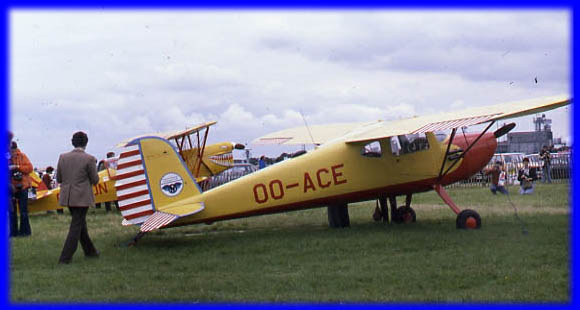 |
Following the wartime success of the Bobcat,
the Cessna 120 was Clyde Cessna's first post-war design. Launched in
1946, it is a two seater powered by an 85hp engine, with a cruising
speed of 100 to 115 mph and endurance of around two hours. Gross
weight is 1,450lb.
Most 120s can be distinguished from 140s by
the absence of a rear quarter light, but this one, pictured at
Leicester in July 1980, strangely, has had it installed. |
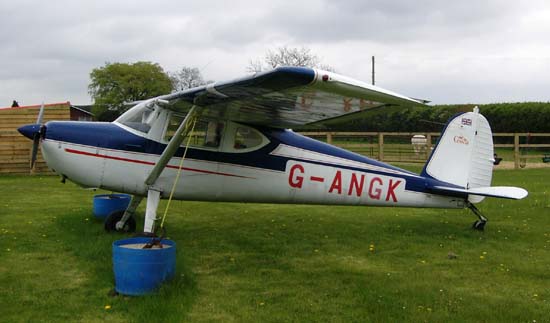 |
The Cessna 140 was a `de luxe' version of the
120, with the same engine and maximum weight, but internal
refinements such as having an electrical system as standard.
Externally they can be told apart (normally) by the rear quarter
light, and the 140A (which had a stronger, aluminium wing) by the
single rather than double wing strut.
This 140A was visiting Top Farm in July 2005.
|
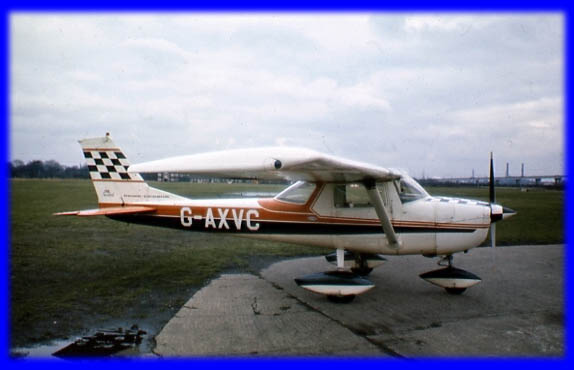 |
The Cessna 150 was introduced in 1957, six
years after production of the 120/140 series ended, so marked
Cessna's re-entry into the two seater market: and what an entry -
with 23,880 built (plus 7,450 of the updated 152 which followed it
into production in 1977), the 150 is one of the top selling aircraft
of all time. It is a small, cheap, simple all metal aircraft,
structurally similar to the 140 but with a swept tail (on all but
the earliest models), nosewheel undercarriage, rear windscreen and
more powerful 100hp engine giving it a maximum weight of 1,500lb and
cruising speed of 115mph. It is a reliable trainer. Many were built
by Reims Aviation in France, several as Aerobats which are stressed
for limited aerobatics.
This Aerobat was at Barton in February 1977. |
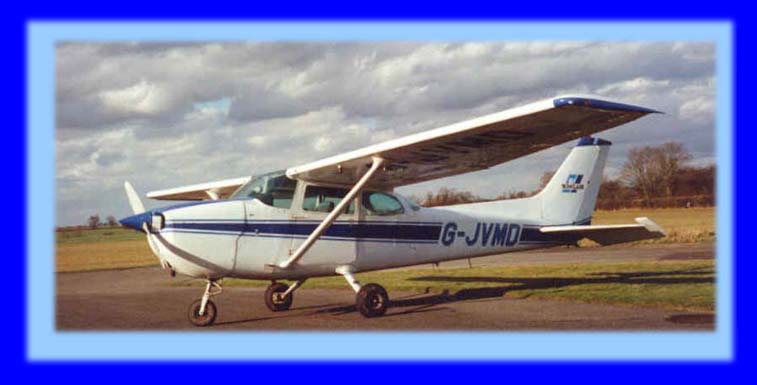 |
The Cessna 172 (many versions of which are
known as the Skylark) probably is the best selling aircraft of all
time, with over 42,500 built (the latest version is still in
production in 2005). Essentially a tricycle version of the 170
(which first flew in 1947), the 172 was introduced in 1955. A four
seater, it is powered by a 145hp engine (though later versions have
160hp), giving it a cruising speed of 108kt and range of 540 miles.
Gross weight is a useful 2,200lb. A small number had retractable
undercarriage. This one was flown by
David into Wickenby in Lincolnshire in 1999. |
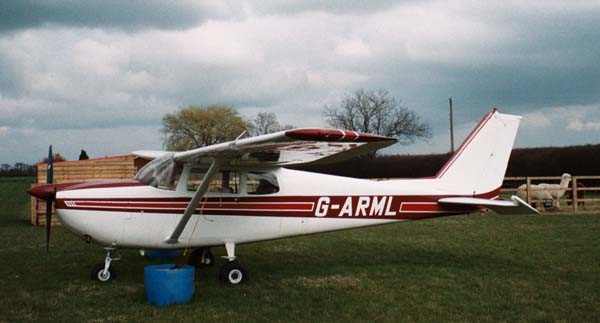 |
The Cessna 175 Skylark was added to the
Cessna range in 1955 to fill the gap between the relatively basic
172 and the punchier 182. It may conveniently be regarded as a `172
de luxe'. With a 175hp engine, it is heavier (2,350lb) and faster
(121kt cruise) than the 172, with most other performance figures
being quite similar. The gap between the two other models was not
really wide enough to justify a separate model; `only' 2,190
Skylarks were built. This one was
visiting Top Farm in June 2005 (and is being admired by the
alpacas!) |
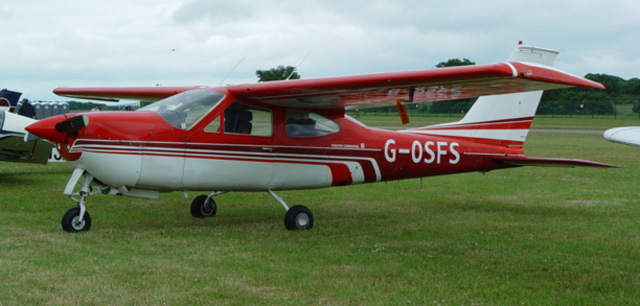 |
The Cessna 177 Cardinal marked a second
attack by Cessna on the perceived space between the 172 and 182.
Also a four seater, the 177 is notable in having a fully cantilever
wing (note the absence of bracing strut), like the larger 210.
Launched in 1967, it was initially powered by a 150hp engine, later
versions increasing to 180. This gave it a cruising speed of 125mph
and range of over 700 miles, with gross weight of 2,350lb (the same
as the 175). About 4,295 Cardinals were built.
Most have retractable undercarriage, including
this one, photographed by Ivy at Kemble in July 2005. |
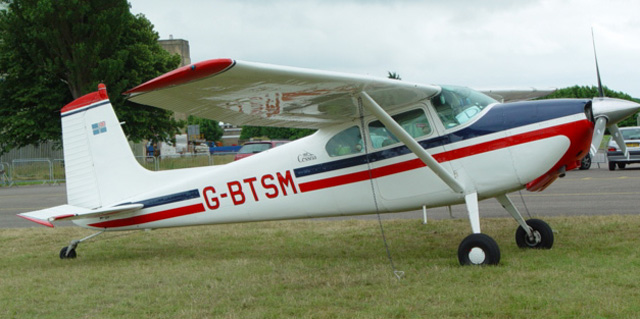 |
Initially introduced in 1952 as a four to six
seat workhorse, the Cessna 180 is a serious utility aircraft. Its
225hp engine gives it a cruising speed of 150mph and range of 730
miles, with a gross weight of 2,550lb and useful load of 1,030lb. It
is a popular light utility aircraft and is also extensively used for
parachuting. 6,210 were built.
This one was also photographed by Ivy at Kemble in July 2005. |
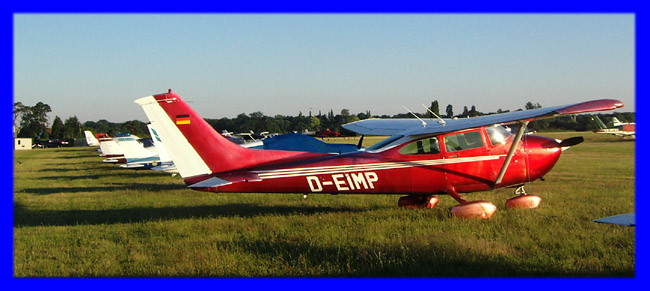 |
The Cessna 182 Skylane started life as a
nosewheel version of the 180, introduced in 1956. Its 230hp engine
gives it similar performance to its forebear, but is slightly
heavier so gives it a little less load carrying ability. Over 21,850
182s were built over several decades, a few of which have
retractable undercarriage. It is a more demanding aircraft to fly
than the 172, but is a much more capable touring machine.
This one was pictured on a late Summer evening at White
Waltham in July 2005) |
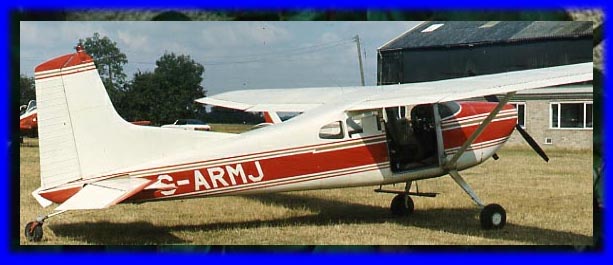 |
The Cessna 185 Skywagon was developed in 1960
as a six seat version of the 180. With a 260hp engine and higher
gross weight of 3,350lb, faster (160kt) cruising speed and longer
(930 miles) range, the Skywagon is a real workhorse. 4,340 were
built, including 480 for the US army as the U-17.
This one was at Peterborough (Sibson) in July
1976. |
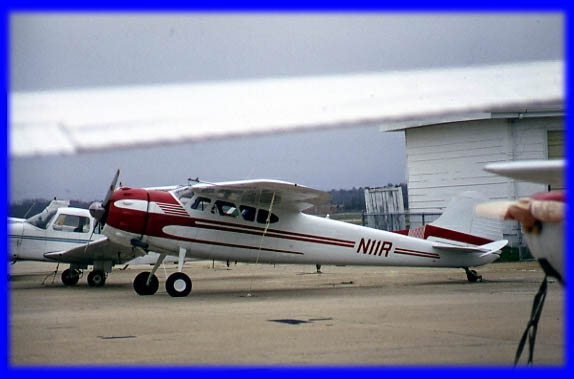 |
The Cessna 195 was introduced in 1947 as
Cessna's competitor to the Beech Bonanza and North American (Ryan)
Navion in the luxury touring aircraft market. A five seater, it is
powered by a massive 275hp Jacobs radial engine. This gave it a
cruising speed of 155mph, but range was only 640 miles - radials are
thirsty! It was thus less popular than the later 210. Still, a
respectable 1,095 were built, including several for the US Air Force
as the C-126. This one was at Cape May
in APril 1986. |
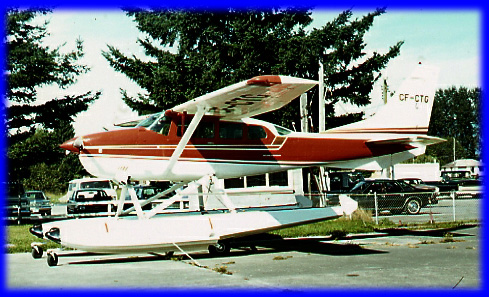
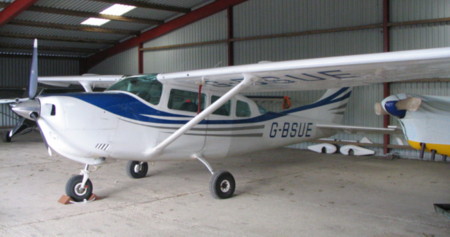 |
The Cessna 206 Stationair is a six seat
utility aircraft introduced in 1962, broadly as a nosewheel
successor to the 185. It is a six seater with a 300hp engine, giving
it a cruising speed of 165mph, range of 750 miles and gross weight
of 3,600lb, with useful load of 1,470lb. It is a versatile utility
aircraft and has been used in many roles, including (as illustrated)
a seaplane version. 7,550 were built (this figure does not include
570 of the earlier 205).
Top: Floatplane at Chilliwack in Canada in September
1981.
Bottom: Top Farm, September 2007. |
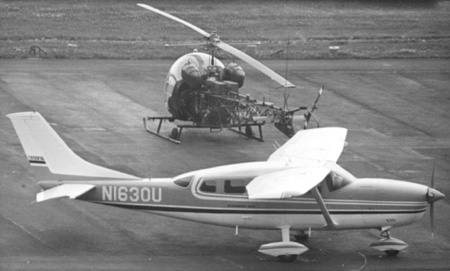 |
The amazing fuselage extension of the Cessna
207 Stationair is clearly visible in this picture. the 207 is
basically a 206, stretched to give an eight seat cabin. It first
flew in 1969. It has the same 300hp engine and broadly the same
performance as the 206. Although 790 were built, its forte is volume
not weight: having the same engine and a bigger structure, its
maximum payload is very similar to the smaller machine.
This picture was taken by David's father at
Newcastle in August 1974. |
|
|
Since its introduction in 1957, the Cessna 210
has been the top of Cessna's single engined range. Many people
regard it as one of the best single engined aircraft ever produced,
which is high praise considering that the competition includes the
likes of the Beech Bonanza, Ryan Navion, Meyers 200 and Bellanca
Cruisair. It is a six seater (though the two in the back must be
pretty uncomfortable), powered by an engine ranging from 285 to
325hp, giving it a cruising speed of 185mph and range of well over
1,000 miles. All versions have a fully cantilever wing and
retractable undercarriage. In all, 9,240 were built.
The top picture is of a standard 210 at Elstree,
date uncertain. The lower picture shows a pressurised T210P at Top
Farm in July 2005. |





|